Table of contents
- Driving safety tips and a change of perspective The dealings between car and motorcycle drivers
- Three golden rules for drivers
- Three golden rules for motorcyclists
Security campaign
Consideration has right of way
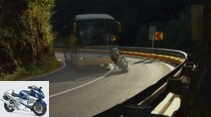
Jorg Kunstle
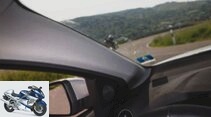



12th pictures
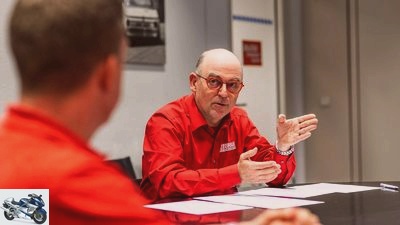
Hannes Bagar, Bosch, Flash Art, Jorg Kunstle, MOTORRAD-Archiv, Arturo Rivas
1/12
Jens Dralle (left), test manager of auto, motor und sport and instructor for car training, and Nicolas Streblow (right), editor at MOTORRAD, instructor for motorcycle training in an expert discussion.
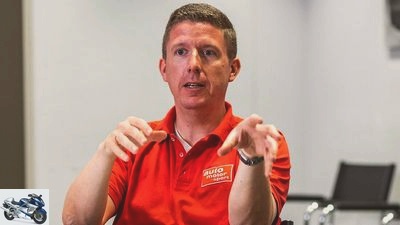
Hannes Bagar, Bosch, Flash Art, Jorg Kunstle, MOTORRAD-Archiv, Arturo Rivas
2/12
Jens Dralle: “Car and motorcycle drivers need to get a feel for where the limits are on their vehicle.”
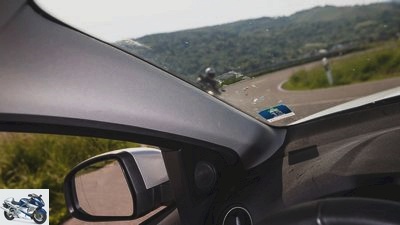
Hannes Bagar, Bosch, Flash Art, Jorg Kunstle, MOTORRAD-Archiv, Arturo Rivas
3/12
Motorcycles are disappearing completely behind the ever-widening A-pillars of modern cars.
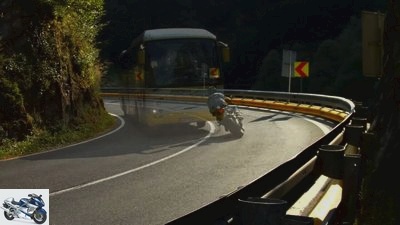
Hannes Bagar, Bosch, Flash Art, Jorg Kunstle, MOTORRAD-Archiv, Arturo Rivas
4/12
Over 90 percent of motorcyclists choose the line shown – arriving safely is then just a coincidence.
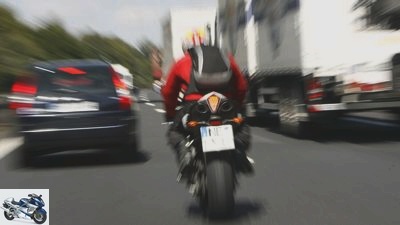
Hannes Bagar, Bosch, Flash Art, Jorg Kunstle, MOTORRAD-Archiv, Arturo Rivas
5/12
Cars brake better than motorcycles: distance and an escape route ensure the motorcyclist’s survival.
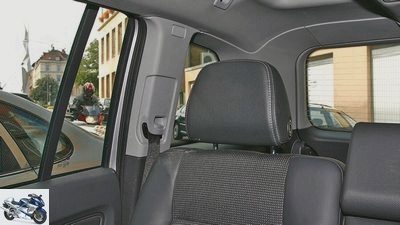
Hannes Bagar, Bosch, Flash Art, Jorg Kunstle, MOTORRAD-Archiv, Arturo Rivas
6/12
Always pass carefully: Drivers leaving a parking space can often only see approaching motorcycles briefly.
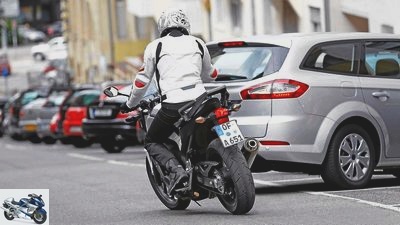
Hannes Bagar, Bosch, Flash Art, Jorg Kunstle, MOTORRAD-Archiv, Arturo Rivas
7/12
The B and C pillars can cover up motorcyclists when pulling out of a parking space.
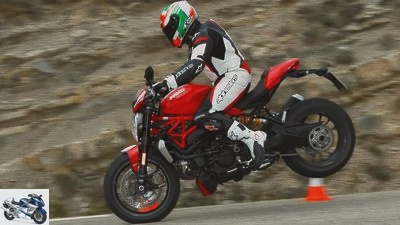
Hannes Bagar, Bosch, Flash Art, Jorg Kunstle, MOTORRAD-Archiv, Arturo Rivas
8/12
Physics is merciless: The lifting rear wheel limits the maximum transferable braking force.
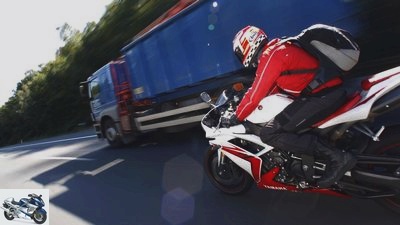
Hannes Bagar, Bosch, Flash Art, Jorg Kunstle, MOTORRAD-Archiv, Arturo Rivas
9/12
Motorcyclists should stay in the blind spot as briefly as possible so as not to be overlooked when changing lanes.
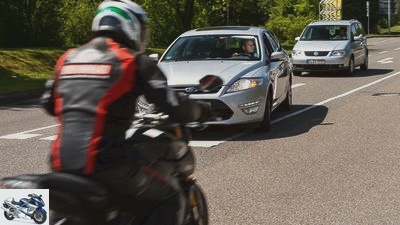
Hannes Bagar, Bosch, Flash Art, Jorg Kunstle, MOTORRAD-Archiv, Arturo Rivas
10/12
Attention, turn left! Approach slowly, ready to brake, honk the horn, if necessary also swerve at the front by braking.
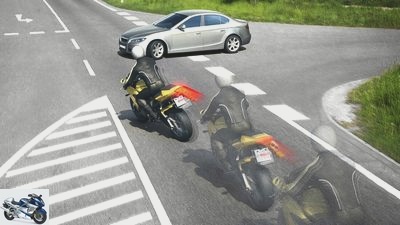
Hannes Bagar, Bosch, Flash Art, Jorg Kunstle, MOTORRAD-Archiv, Arturo Rivas
11/12
Maybe even modern sensor and control technology can help prevent such accidents in the future.
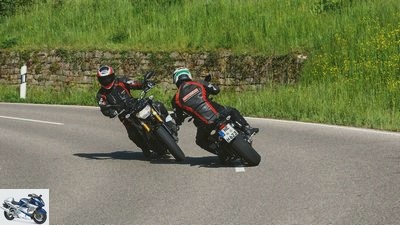
Hannes Bagar, Bosch, Flash Art, Jorg Kunstle, MOTORRAD-Archiv, Arturo Rivas
12/12
With your body completely on the opposite lane – how often have you caught yourself doing it??
counselor
Driving experience & Driving tips
On the interaction between car and motorcycle drivers
Driving safety tips and a change of perspective
The dealings between car and motorcycle drivers
Encounters between two- and four-wheelers are often characterized by mistrust, incomprehension and a lack of knowledge of the other’s point of view. Suggestions for a better relationship.
The interview was conducted by Martin Ehrenfeuchter
05/27/2021
Let’s get straight to the point right from the start: Car or motorcyclists – who is to blame more often in accidents and why?
Nicolas Streblow: Statistically, that is quite clear. Most of the time, the driver is to blame. When a motorcycle collides with another road user, a car driver is the main culprit in 80 percent of cases. If one looks at the collisions between car drivers and motorcyclists with personal injury, then in two thirds of the cases the car driver is responsible for causing the accident. The reasons are complex. Motorized two-wheelers are often not, or at least not correctly, noticed by other road users. Often a motorcycle is simply overlooked due to its slim silhouette, or it disappears for a short time behind a lamp post or the A-pillar of the car. That’s enough for a crash.
Buy complete article

Drive well and safely
On the interaction between car and motorcyclists
8 pages) as PDF
€ 2.00
Buy now
Jens Dralle: If you take a closer look at the two road users, I discover a fundamental difference. I firmly believe that very few motorcyclists get on their two-wheelers because they have to. It looks very different with car drivers. For many people, the car is simply a means of getting around. As a result, drivers are more easily distracted, for example by smartphones. In the worst case, this can lead to accidents. Then there is the uncertainty. Drivers find it increasingly difficult to estimate the dimensions of their vehicle and the speed of other road users. I notice that on the autobahn, for example. Lots of people there are insecure. There is no feeling for the flowing traffic. In addition, the vehicle dimensions are getting bigger and bigger. If I’m in a station wagon at a right-turn intersection, but an SUV blocks my view to my left and a motorcyclist intervenes on the priority road, things can quickly become dangerous.
In which places can it become particularly dangerous??
Streblow: The main cause of single accidents among motorcyclists is leaving the curve. If there is oncoming traffic, this can of course be doubly dangerous. In these cases, the issue is not too high a speed, but rather the lack of driving ability of the respective driver. You drive a motorcycle with your whole body, using steering impulses and gaze guidance. In other words, a motorcyclist has to look where he wants to go. A vehicle that is steered by one’s own body always goes where the driver is looking. The greatest danger for motorcyclists is when their eyes stick to the edge of the lane instead of looking predominantly at the exit of a curve. In curves, bikers should always use the dynamic safety line whenever possible. Approach the left-hand bend on the right-hand side of the road and pull in late. Then I can look far into the curve and my head is on my side. This way I can see the exit from the curve and any oncoming traffic earlier and am also seen earlier myself. Right-hand bends must be approached at the center line and then switch to my side until the end of the bend on the right. In this way I avoid the risk of being carried onto the oncoming lane. Very few motorcyclists fall in a curve because they are really too fast, but rather because their visual guidance is poor and they do not dare to take a more lean angle. For outsiders, a motorcyclist who drives around the curve at a 35 degree incline far away from any border area at normal country road speed looks spectacular. But that’s not daring, it’s a physical necessity.
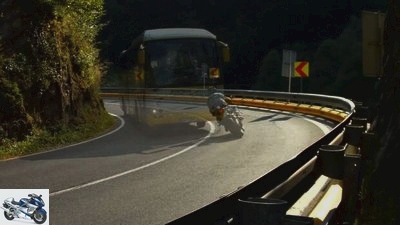
Hannes Bagar, Bosch, Flash Art, Jorg Kunstle, MOTORRAD-Archiv, Arturo Rivas
Over 90 percent of motorcyclists choose the line shown – arriving safely is then just a coincidence.
Twist: This said “Daring” is often accused of the driver. When I turn a corner like I can take, people think I’m insane. But I am not. I learned cornering. I enjoy it and don’t break the speed limit. I know what I can do with the car under the prevailing conditions. But not everyone has this practical experience. And it is the same with motorcyclists. At the same time, bikers need to know that the driver’s all-round view is also restricted by the A-pillar when cornering. In order to avoid accidents, both sides are advised to keep too much rather than too little distance from the central reservation when cornering. Cutting the curve is taboo anyway.
If the subject “speed” poses no problem in the curve, how does it look on the straight line?
Twist: Excessive speed is an issue that affects both motorists and motorcyclists. But I have the feeling that this problem is tending to decrease, at least for drivers. Five years ago it still happened relatively often that even at a higher speed there was one or the other jostling who came in from behind on the autobahn and wanted to pass. That has decreased, but the discomfort has increased. What shakes me, however, is this obvious inability to estimate the speed and the traffic behind. This carefree change of lane. Often for no reason. Without blinking. They then move from the right-most to the left-hand lane at a speed of 100 and ideally check any social media apps at the same time. Yes, I also use the phone while driving. But if I do that, then with a hands-free device on the right-hand lane while maintaining the recommended speed. For motorcyclists, on the other hand, the subject of speed is certainly more present. Bikers are usually on the road because they want to be. That’s why, in my opinion, they tend to be more ambitious. In other words, we experience a discrepancy in terms of motivation for driving in leisure traffic. That would be a little more serenity and tolerance towards the goals of others, with whom I just happen to have to share the road “problem” already reduce.
Streblow: Motorcycles usually accelerate much better than cars. You can drive away from dangerous situations at times. Often, however, it is best to keep control of a situation yourself by braking and keeping your distance. If I see someone in front of me who does weird things and who I can’t judge, then I’d better take it slowly. I take a step back, keep a little more distance and leave more space between myself and the others. If it’s free, I’ll be gone quickly. It would be nice if some motorcyclists would think about the impression they are making on others with their behavior. A few weeks ago I was on my way from Frankfurt to the Ruhr area when a group of motorcyclists came shot from behind on the country road. They passed in places where I wouldn’t have thought about it in my life. Especially not with a column. Have ruthlessly pushed themselves in between. Not only were they fast, they were also loud. Exactly the category that all motorists (and local residents) rightly complain about, regardless of whether they are sitting on the motorcycle or in the car. Both sides would be well advised to slow down their own ego from time to time and to be considerate of each other.
keyword “consideration”: It can also be dangerous when pulling out of a parking space or turning. How should motorists and motorcyclists behave ideally here??
Streblow: Wherever cars potentially want to turn around or protrude back into the street when pulling out of a parking space, we have a double problem. On the one hand, because the B- and C-pillars in the car or any traffic sign hide the motorcyclist. On the other hand, because as a driver it is difficult to assess the speed of a two-wheeler. If a situation arises somewhere in which car drivers park out, then as a motorcyclist I don’t just zoom past it because I have the right of way. I have to be ready to brake. I have to make myself visible, for example by changing to the left side of my lane, combined with a slight brake nod. Anything that brings movement into the silhouette increases attention. Any kind of change in the angle of incidence from the headlight into the driver’s field of vision increases his perception and improves the chance of being seen.

fact
The B and C pillars can cover up motorcyclists when pulling out of a parking space.
Twist: Drivers should turn their heads three or more times, especially when turning. If you can see a motorcycle in the distance, be sure to wait. It is difficult for drivers to correctly assess how fast a motorcycle is really going and when it will pass my position. If, on the other hand, a motorcyclist realizes that a motorist is about to turn around, slow down and turn the steering, he should take the initiative and draw attention to himself. Among other things, motorcycles have a horn for this purpose, the use of which is wrongly frowned upon in our part of the world. Here she can help. Once that is anchored in the heads of both road users, then I have already made both sides aware of the situation.
Why does it still happen that motorcyclists or car drivers do not recognize the action of the other, or recognize it too late?
Streblow: I don’t even think that the situation is recognized too late. Rather, very few can imagine their effects. This is where braking comes into play. Even if a biker detects a car’s brake lights, they may not know how quickly the car is actually losing speed. The potential to reduce speed is much higher with a car than with a motorcycle. Cars brake much better than motorcycles, stopping on average at 100 km / h about five meters earlier, i.e. at 35 instead of 40 meters. The impact speed is therefore at least 30 km / h. With an older motorcycle without ABS, 50 meters of braking distance are easily required, so you crash into the rear at 50 km / h. These are the pure braking distances. If we add the reaction time, there is no chance without sufficient distance. We must not forget that well over half of motorcycles do not have ABS. Motorcyclists are therefore well advised not to drive in the middle behind a car, but offset to the left. The driver should know that in this situation the motorcyclist does not want to pass by, but to be seen better through the left mirror. This also improves the view past the car, especially with SUVs and vans, and increases the chance of detecting a possible emergency braking early on.
Twist: Keyword ABS. Unfortunately, it is often the case that road users are increasingly relying on their assistance systems. But one shouldn’t demonize these assistants. We had it from backing out of a parking space. For these situations there are now helpers that are subject to a surcharge. The cross traffic assistant, for example, signals to me on the display and with warning tones whether there is danger from the left or right. In case of doubt, the system even brakes itself. Assistance systems for semi-autonomous driving now work very reliably. But only at low speeds in the stop-and-go area. An assistance system, as the name says, is supposed to assist the driver. But it does not relieve him of responsibility. Many people forget that, as you can already see from the bizarre accidents with various autopilots. As a result, some drive without concentration and accidents occur.
So many of these accidents are avoidable?
Streblow: Yes, if both road users give each other a chance. As a motorcyclist, for example, I shouldn’t drive next to a car on a four-lane road where the driver can’t see me in my blind spot. A sudden lane change catches me cold, so it’s better to either drive past or stay behind, but not next to it. Many car drivers also underestimate the speed of motorcycles when turning left. If a motorcyclist approaches an intersection at 100 instead of the permitted 70 km / h, then he covers 100 meters in a good three seconds rather than five. This cannot be assessed for a slow driver on the waiting road. 100 meters seem like a lot, some people still pull out. The position of the sun also affects visibility. If I have a long shadow in front of me, then I have the sun behind me. My oncoming traffic sees me much worse. As a motorcyclist, I have to adjust to that. When cars are in cross traffic or even want to turn left out of oncoming traffic directly in front of the motorcycle, bikers have to be ready to brake, never exceed the speed limit and expect the driver not to notice them or the motorcycle, for example behind the Column, disappears completely. Collisions with left-turners in oncoming traffic are one of the most common accidents! Here, too, I can draw attention to myself again with slight wavy lines and braking nods and, regardless of the situation, I should rather brake again if in doubt.
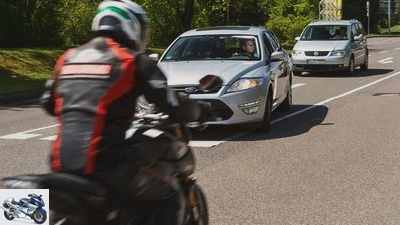
Jorg Kunstle
Attention, turn left! Approach slowly, ready to brake, honk the horn, if necessary also swerve at the front by braking.
Twist: I think that drivers in particular should learn to drive more consciously again. They need to know how to use the assistance systems correctly, if they are available. The technology is often explained to them far too seldom. Private customers usually buy a young used vehicle. I strongly doubt whether they will receive a perfect briefing. But that would be important because a car has become a complex device. Technology needs to be used consciously, because it in no way releases me as a driver from my duty, for example, to brake properly or to correctly assess speeds. When I’m unsure, I prefer to slow down. In the end, I’m still the one with my feet on the pedals and my hands on the steering wheel – in other words, the one who is responsible for what I do.
Let’s stay with the assistance systems: Which are the most effective in the interplay between car and motorcycle?
Twist: The most important assistance system sits between the driver’s ears, always with both road users. Only then do the technical aids come. The car itself offers optimal conditions through the modern chassis technology right up to the steering in order to be able to react in an emergency. ABS and ESP are actually standard. The automatic distance control and the blind spot assistant with beeps, lights and the warning triangle in the exterior mirror are sure to help. However, the systems do not work in all weather conditions. The camera behind the windshield may fail in heavy rain or snow. The most important assistance system for me is therefore the headlights. When it comes to configuring a new vehicle, I would advise everyone not to skimp on lighting. The manufacturers now offer great headlight systems. They are able to optimally illuminate the road and signs, even taking into account the traffic ahead or oncoming traffic. In conjunction with night vision systems, the driver can also recognize pedestrians better. But again: the technology does not release me from my duties as a driver.
Streblow: That is the point. Even in the motorcycle sector, every aid is nice, but it is an aid. Ideally, however, you drive as if you didn’t have any. ABS and anti-slip control are emergency systems that prevent worse in the event of incorrect operation or when frightened. But as soon as a motorcyclist feels an assistance system, he has already made the mistake and is on the move beyond the physical limits. A motorcycle has traction control at the rear, but not at the front. If it is slippery, I can slip away without braking, even at a slight angle. You have to feel that beforehand. This feeling is even more important for a motorcyclist than for a motorist. But sometimes it also means that people are very focused and like to hide the fact that there are others around them. Motorcyclists should therefore try out all assistance systems at a driver training course in order to know how their intervention works and where their limits are.
So can driving and safety training really help to be safer and more considerate on the road?
Streblow: Necessarily. Car and motorcycle drivers need to get a feel for where the limits are on their vehicle. You can only learn that with driver safety training. Someone who does not want to get to know the limits because he resolves never to cross them will be terribly surprised, even downright frightened, if he does reach them. Then he will make a mistake even more. I think that’s negligent. As a driver, I need to know what my vehicle is doing and when and how I can prepare for it. Besides, it’s not just about extreme situations. The participants also receive valuable tips on vehicle control and correct behavior in traffic. It starts with balance training, the correct driving line, the aforementioned visual guidance and training in the possible and required lean angle. To initiate this via a conscious steering impulse, you also learn that in a driver safety training course. An important part of the training is also the right braking, a topic in which many participants in a safety training make enormous progress in a short time.
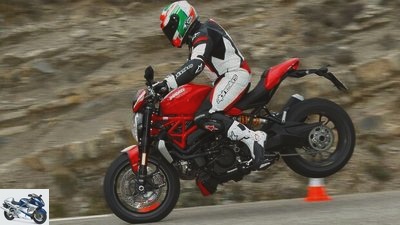
Flash Art
Physics is merciless: The lifting rear wheel limits the maximum transferable braking force.
Twist: Yes, it’s very similar with car training. Many believe that they have already made hundreds of emergency stops. Most, however, have no clue what an emergency stop really is. They are frightened when the brake pedal pulsates and think they are breaking something. The participants are confronted with such situations and attention is trained. Ultimately, that is the bottom line.
What else can increase safety for both road users on the road??
Streblow: We have already mentioned the light. This is definitely extremely important, especially with motorcycles. Modern motorcycles with daytime running lights should do that “right one” Turn on the lights so that you don’t get lost among all the cars with daytime running lights. Motorcyclists can also set accents with their clothing. Many suppliers have neon colors on offer. Luminous clothes and a red or white helmet increase visibility. A safety vest is not the last word in wisdom, you should save it in an emergency, then rather wear a helmet in neon color.
Twist: In my opinion, the tire is the most important safety feature of any car, regardless of age and equipment. Especially when it is wet, it becomes clear how great the differences in quality are on the market. Many underestimate that. Especially drivers who are already unsure shouldn’t be stingy when choosing tires.
What tip would you give the other road user to finish off with?
Streblow: The enemy is the fright because it paralyzes. In order to remain able to act, road users must be attentive and trained in order to be able to react adequately to as many events as possible. It doesn’t matter whether you are traveling by car or motorcycle, you should always be prepared for the wrongdoing of others. The seventh sense is not witchcraft, but arises through thinking ahead and thinking ahead. Everyone should raise their awareness on the road and drive with awareness. It’s best to start with yourself, because at first I can only change something about myself. With this attitude alone, we can take a big step forward.
Twist: As a road user, I should never expect others to think along for me and pay for my mistakes. Nor can I expect the infrastructure to improve. For everyone involved in road traffic, this means: Drive with foresight and anticipation. I have to know the potential of my vehicle and be clear about what I can and cannot do. If in doubt, everyone should register again for a safety training course.
Three golden rules for drivers
1. Better to look three times: Motorcycles are narrow and accelerate quickly. Even if you are driving at the correct speed, you are there faster than expected and can easily be overlooked. At an intersection, do not pull out in front of an approaching motorcycle. When it’s over, it will rarely get in the way of you.
2. Distance in curves: When a motorcycle – especially when it is wet – slowly drives into a curve, keep sufficient distance. The possibly cautious candidate in front of you will otherwise only become more insecure, but not guaranteed any faster.
3. Partnership: Today, motorcyclists are on average almost 45 years old and mostly not young and wild to be put in their place. Show the respect you expect.
Three golden rules for motorcyclists
1. Make yourself noticeable before dangerous situations: Even slight evasive movements or steering movements increase the car driver’s attention.
2. Do not insist on your own right of way: release the accelerator in good time and be ready to brake. Do not expect anyone to count on you.
3. Take the mistakes of others into account: Always drive with foresight so as not to be left behind.
Related articles
-
Report: Out and about with motorcycle buyers
Dentges counselor Used purchase Report: Out and about with motorcycle buyers Report: Out and about with motorcycle buyers The professionals give tips on…
-
The right tire choice for a motorcycle
Markus Jahn 26th pictures MOTORCYCLE 1/26 On the way on alpine passes? That’s how it works! MOTORCYCLE 2/26 Seductive winding curves with risk. The…
-
FEMA survey on combustion motorcycle ban
Galfer counselor traffic & business FEMA survey on combustion motorcycle ban Survey on possible combustion bans FEMA wants motorcyclist opinions Possible…
-
IG Moto motorcycle noise volume initiative
Motorcycle noise Debate about the volume of motorcycles Eva Breutel 6th pictures Eva Breutel 1/6 The committed test team of the Austrian IG Moto after…
-
On the road in Denmark by motorcycle
Daams 14th pictures Daams 1/14 Time for the rain suit: a short shower on the way to Tyboren. Motorcycling in Denmark between the North Sea and the Baltic…
-
Motorcycle tour Altiplano Chile and Bolivia
Biebricher, Werel 23 pictures Biebricher, Werel 1/23 The plateau is more than 3300 meters above sea level. This is not only felt by the human body, but…
-
Motorcycle trip – with Honda to the North Cape
Honda to travel Motorcycle trip – with Honda to the North Cape Motorcycle trip – with Honda to the North Cape Makes a dream Go to the northernmost point…
-
Motorcycle exhaust sound design
BMW accesories Exhaust & silencer Motorcycle exhaust sound design Exhaust special Sound hobbyist Content of The sound of our motorcycles is no…
-
Lights on motorcycle clothing and helmets
manufacturer 13th pictures manufacturer 1/13 The retrofittable Held Light System (HLS) is the latest development from Held. The LED modules light up…
-
No new basis for motorcycle driving bans
Motorcycle noise Debate about the volume of motorcycles Ralf Schneider counselor traffic & business No new basis for motorcycle driving bans Amendment of…